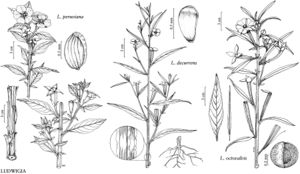Ludwigia peruviana
J. Jap. Bot. 28: 293. 1953.
Herbs often woody at base, with peeling bark. Stems usually ridged, rarely succulent, profusely branched, 100–400 cm, usually villous, rarely glabrous, hairs deciduous in age, multicellular, usually tawny. Leaves: stipules deciduous, narrowly deltate, 1–1.5 × 0.3–0.5 mm, setaceous; petiole 0–1.5 cm; blade usually lanceolate, elliptic or broadly elliptic, sometimes ovate, obovate, or rounded, 2–45 × 1–10 cm, base obtuse or cuneate, rarely asymmetrical, margins entire or gland-toothed, apex usually acute or acuminate, rarely rounded and emarginate, mostly scabrid, membranous or papery, surfaces usually villous, sometimes glabrous; bracts usually not strongly reduced. Inflorescences leafy racemes, flowers solitary in distal axils; bracteoles deciduous, usually attached near base or on lower 1/2 of ovary, sometimes on upper pedicel, subtended by reduced, glandlike stipels, ovate or lanceolate to linear, 5–20 × 1–6 mm, apex acute or short-acuminate, surfaces villous. Flowers: sepals ovate or ovate-lanceolate, 10–23 × 4–9 mm, apex acute or short-acuminate, sometimes glandular-serrulate; petals bright yellow, orbiculate or obovate, 10–40 × 10–40 mm, apex rarely emarginate, short-clawed; stamens 8(or 10) in 2 unequal series, yellow, shorter filaments 1.5–4 mm, longer ones 3.5–5 mm, anthers oblong, 3–6 mm; ovary obconic, 4- or 5-angled, sometimes subterete, 5–20 × 3–7 mm, narrowed to pedicel, usually densely villous, sometimes glabrous; nectary disc elevated 0.3–3.2 mm on ovary apex, 4–6 mm diam., 4(or 5)-lobed, sunken, ringed by long, white hairs; style 1.5–3.5 mm, stigma globose, 1.6–3.5 × 1.8–3.5 mm, usually as long as stamens, rarely exserted beyond them. Capsules ± sharply 4- or 5-angled, 10–40 × 6–13 mm, thin-walled, irregularly dehiscent, pedicel 5–65 mm. Seeds brown or reddish brown, oblong, 0.6–0.9 × 0.3–0.4 mm, rounded at ends, with inconspicuous raphe. 2n = 64, 80, 96, 128.
Phenology: Flowering Jun–Aug(–Sep) (sometimes in any month).
Habitat: Wet places, ditches, drainage canals, sloughs, swales, marshy shores, wet clearings.
Elevation: 0–200[–2600] m.
Distribution
Ala., Fla., Ga., N.C., Tex., Mexico (Chiapas, Durango, Oaxaca, Puebla, Tabasco, Veracruz), West Indies, Central America, South America, introduced in Eurasia (India, Indonesia, Singapore, Sri Lanka), Australia.
Discussion
Ludwigia peruviana is sometimes cultivated and naturalized, which may account for occurrences in North America and Eurasia. Except in the Amazon basin, where it is known only from few collections in western Amazonia, and in northeastern Brazil, where it is scarce, L. peruviana is common throughout its range, and may behave as a weed, especially along slow-flowing canals and drainage ditches. Ludwigia peruviana is also naturalized at scattered localities in Asia (P. H. Raven 1963[1964]) and around Sydney, Australia. The earliest collection from Asia is labeled “ex horto bot. Bogoriensi Javae misit 1869” (Raven). It also occurs locally in the Nilgiri Mountains of southwest India and in Sri Lanka, as well as in scattered locations in Bangka, Java, Malaysia, and Sumatra from sea level to 1000 m (Raven 1963[1964], 1978).
Jussiaea grandiflora Ruíz & Pavon, a synonym for J. peruviana Linnaeus, appeared in 1830, not in 1802 (P. A. Munz 1942; P. H. Raven 1963[1964]); it is a later homonym of J. grandiflora Michaux (1803), as reported in W. Greuter and T. Raus (1987). Jussiaea hirta (Linnaeus) Swartz is an illegitimate homonym and J. hirta (Linnaeus) Vahl is an illegitimate isonym; both pertain here.
Selected References
None.
